The Critical Capture Velocity of Coal Ash Particles Oblique Impact on a Stainless Steel Surface
Abstract
:1. Introduction
2. Experimental System and Methods
2.1. Experimental System
2.2. Parameter Measurement
2.3. Numerical Calculation Method
3. Results and Discussion
3.1. Normal Restitution Coefficient
3.2. Prediction of Critical Capture Velocity by the Three Models
3.2.1. Critical Damping Coefficient
3.2.2. Critical Capture Velocity
3.2.3. Effect of Particle Diameter and Incident Angle on Critical Capture Velocity
4. Conclusions
Author Contributions
Funding
Institutional Review Board Statement
Informed Consent Statement
Data Availability Statement
Acknowledgments
Conflicts of Interest
Nomenclature
| Symbol description | |
| center distance between two particles (m) | |
| particle diameter (m) | |
| particle pixel diameter (pixel) | |
| normal restitution coefficient obtained by calculated | |
| normal restitution coefficient obtained by experiment | |
| particle mass (kg) | |
| equivalent mass (kg) | |
| particle radius (m) | |
| particle pixel area (pixel²) | |
| initial velocity (m/s) | |
| terminal velocity (m/s) | |
| critical capture velocity (m/s) | |
| plastic yield velocity (m/s) | |
| contact displacement (m) | |
| the displacement at time (m) | |
| time interval (s) | |
| particle elastic modulus (GPa) | |
| equivalent elastic modulus (GPa) | |
| total force (N) | |
| attractive force (N) | |
| repulsive force (N) | |
| pixel value in 2 mm | |
| equivalent radius (m) | |
| incident velocity (m/s) | |
| rebound velocity (m/s) | |
| incident normal velocity (m/s) | |
| rebound normal velocity (m/s) | |
| Poisson’s ratio | |
| damping coefficient | |
| surface energy (kJ/m²) | |
| adhesion work per unit area (kJ/m²) | |
| incident angle (°) | |
| rebound angle (°) | |
| pixel displacement (pixel) | |
| interval time (s) | |
| Superscript description | |
| * | equivalent |
| H | Hertz model |
| DMT | Derjaguin, Muller, and Toporov model |
| BD | Brach and Dunn model |
| Script description | |
| 1 | particle |
| 2 | target |
References
- Dahneke, B. The capture of aerosol particles by surfaces. J. Colloid Interface Sci. 1971, 37, 342–353. [Google Scholar] [CrossRef]
- Dahneke, B. Measurements of bouncing of small latex spheres. J. Colloid Interface Sci. 1973, 45, 584–590. [Google Scholar] [CrossRef]
- Dahneke, B. Further measurements of the bouncing of small latex spheres. J. Colloid Interface Sci. 1975, 51, 58–65. [Google Scholar] [CrossRef]
- Rogers, L.N.; Reed, J. The adhesion of particles undergoing an elastic-plastic impact with a surface. J. Phys. D Appl. Phys. 1984, 17, 677. [Google Scholar] [CrossRef]
- Dunn, P.F.; Brach, R.M.; Janson, G.G. Surface-Contact Mechanics During Oblique Impact of Microspheres with Planar Surfaces. Aerosol Sci. Technol. 1996, 25, 445–465. [Google Scholar] [CrossRef]
- Li, X.; Dunn, P.F.; Brach, R.M. Experimental and numerical studies on the normal impact of microspheres with surfaces. J. Aerosol Sci. 1999, 30, 439–449. [Google Scholar] [CrossRef]
- Zhang, Y.; Fang, Z.; Zhao, S.; Wei, M.; Wu, X.; Sun, L. An experimental study on the wall collision of micro-sized graphite particles by high-speed photomicrography. Prog. Nucl. Energy 2020, 125, 103391. [Google Scholar] [CrossRef]
- Kim, O.V.; Dunn, P.F. Direct visualization and model validation of microsphere impact and surface capture. J. Aerosol Sci. 2008, 39, 373–375. [Google Scholar] [CrossRef]
- Sommerfeld, H.; Koch, C.; Schwarz, A.; Beck, A. High velocity measurements of particle rebound characteristics under erosive conditions of high pressure compressors. Wear 2021, 470, 203626. [Google Scholar] [CrossRef]
- Tiamiyu, A.A.; Sun, Y.; Nelson, K.A.; Schuh, C.A. Site-specific study of jetting, bonding, and local deformation during high-velocity metallic microparticle impact. Acta Mater. 2021, 202, 159–169. [Google Scholar] [CrossRef]
- Wall, S.; John, W.; Wang, H.-C.; Goren, S.L. Measurements of Kinetic Energy Loss for Particles Impacting Surfaces. Aerosol Sci. Technol. 1990, 12, 926–946. [Google Scholar] [CrossRef]
- Ming, D.; Li, S.; Xie, J.; Jian, H. Experimental Studies on the Normal Impact of Fly Ash Particles with Planar Surfaces. Energies 2013, 6, 3245–3262. [Google Scholar]
- Li, S.; Xie, J.; Dong, M.; Bai, L. Rebound characteristics for the impact of SiO2 particle onto a flat surface at different temperatures. Powder Technol. 2015, 284, 418–428. [Google Scholar] [CrossRef]
- Li, X.; Dong, M.; Li, S.; Shang, Y. Experimental and theoretical studies of the relationship between dry and humid normal restitution coefficients. J. Aerosol Sci. 2019, 129, 16–27. [Google Scholar] [CrossRef]
- Konstandopoulos, A.G. Particle sticking/rebound criteria at oblique impact. J. Aerosol Sci. 2006, 37, 292–305. [Google Scholar] [CrossRef]
- Aylor, D.E.; Ferrandino, F.J. Rebound of pollen and spores during deposition on cylinders by inertial impaction. Atmos. Environ. 1985, 19, 803–806. [Google Scholar] [CrossRef]
- Gibson, L.; Gopalan, B.; Pisupati, S.V.; Shadle, L.J. Image analysis measurements of particle coefficient of restitution for coal gasification applications. Powder Technol. 2013, 247, 30–43. [Google Scholar] [CrossRef]
- Kuuluvainen, H.; Arffman, A.J.; Rvinen, A.; Harra, J.; Keskinen, J. The effect of materials and obliquity of the impact on the critical velocity of rebound. Aerosol Sci. Technol. 2017, 51, 301–310. [Google Scholar] [CrossRef] [Green Version]
- Sondergaard, R.; Chaney, K.; Brennen, C.E. Measurements of Solid Spheres Bouncing Off Flat Plates. J. Appl. Mech. 1990, 57, 694–699. [Google Scholar] [CrossRef]
- Xie, J.; Zhu, Z.; Yang, T.; Dong, M.; Li, R. The effect of incident angle on the rebound behavior of micro-particle impacts. J. Aerosol Sci. 2021, 155. [Google Scholar] [CrossRef]
- Brach, R.M.; Dunn, P.F.; Li, X. Experiments and Engineering Models of Microparticle Impact and Deposition. J. Adhes. 2000, 74, 227–282. [Google Scholar] [CrossRef]
- Beek, V.M.; Rindt, C.C.; Wijers, J.J.; Steenhoven, V. Rebound characteristics for 50-μm particles impacting a powdery deposit. Powder Technol. 2006, 165, 53–64. [Google Scholar] [CrossRef]
- Li, X.; Dunn, P.F.; Brach, R.M. Experimental and Numerical Studies of Microsphere Oblique Impact with Planar Surfaces. J. Aerosol Sci. 2000, 31, 583–594. [Google Scholar] [CrossRef]
- Maugis, D. Contact, Adhesion and Rupture of Elastic Solids; Springer: Berlin/Heidelberg, Germany, 2000. [Google Scholar]
- Derjaguin, B.V.; Muller, V.M.; Toporov, Y.P. Effect of contact deformations on the adhesion of particles. J. Colloid Interface Sci. 1975, 53, 314–326. [Google Scholar] [CrossRef]
- Brach, R.M.; Dunn, P.F. Macrodynamics of Microparticles. Aerosol Sci. Technol. 1995, 23, 51–71. [Google Scholar] [CrossRef]
- Thornton, C.; Ning, Z. A theoretical model for the stick/bounce behaviour of adhesive, elastic-plastic spheres. Powder Technol. 1998, 99, 154–162. [Google Scholar] [CrossRef]
- Matsunaga, T.; Kim, J.K.; Hardcastle, S. Crystallinity and selected properties of fly ash particles. Mater. Sci. Eng. A 2002, 325, 333–343. [Google Scholar] [CrossRef]
- Ledbetter, H.M. Stainless-steel elastic constants at low temperatures. J. Appl. Phys. 1981, 52, 1587–1589. [Google Scholar] [CrossRef]
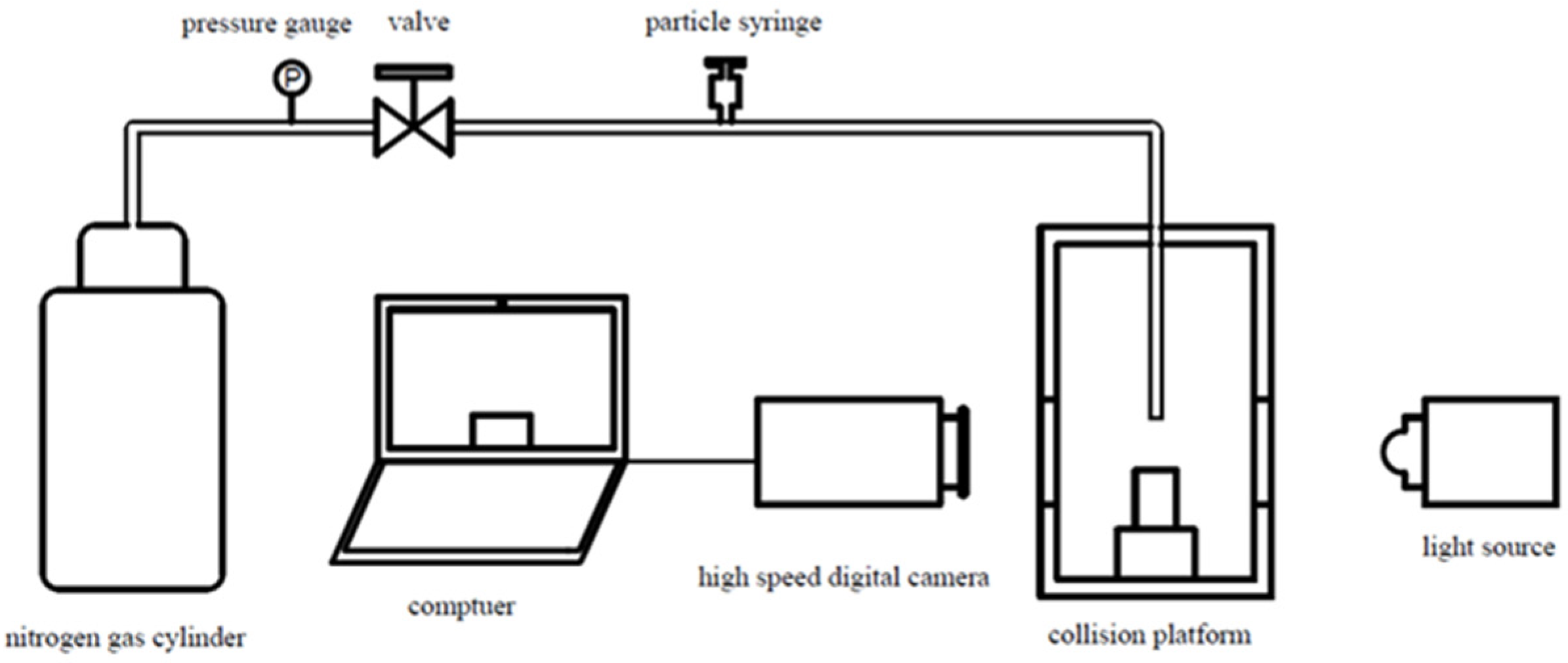
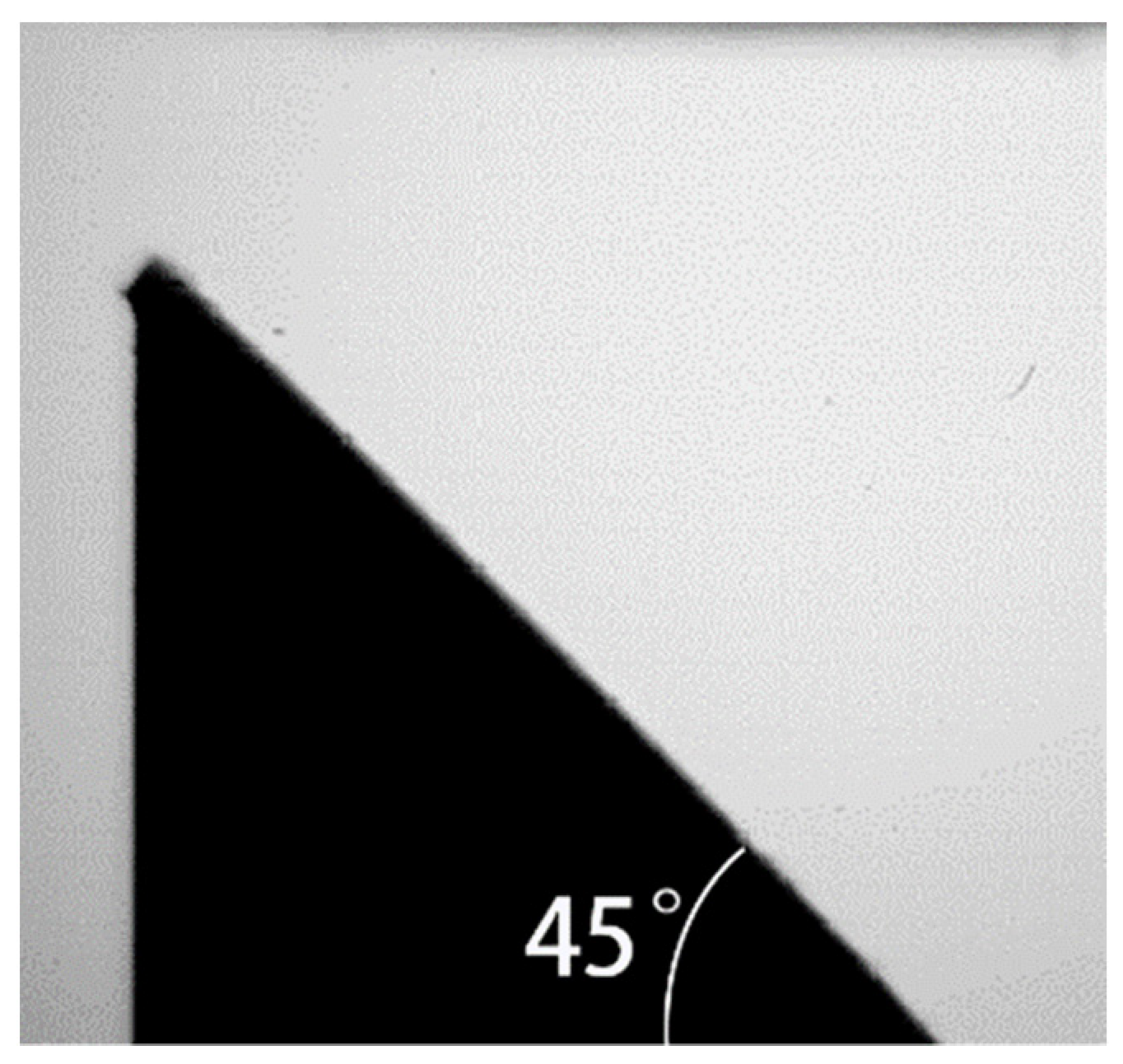

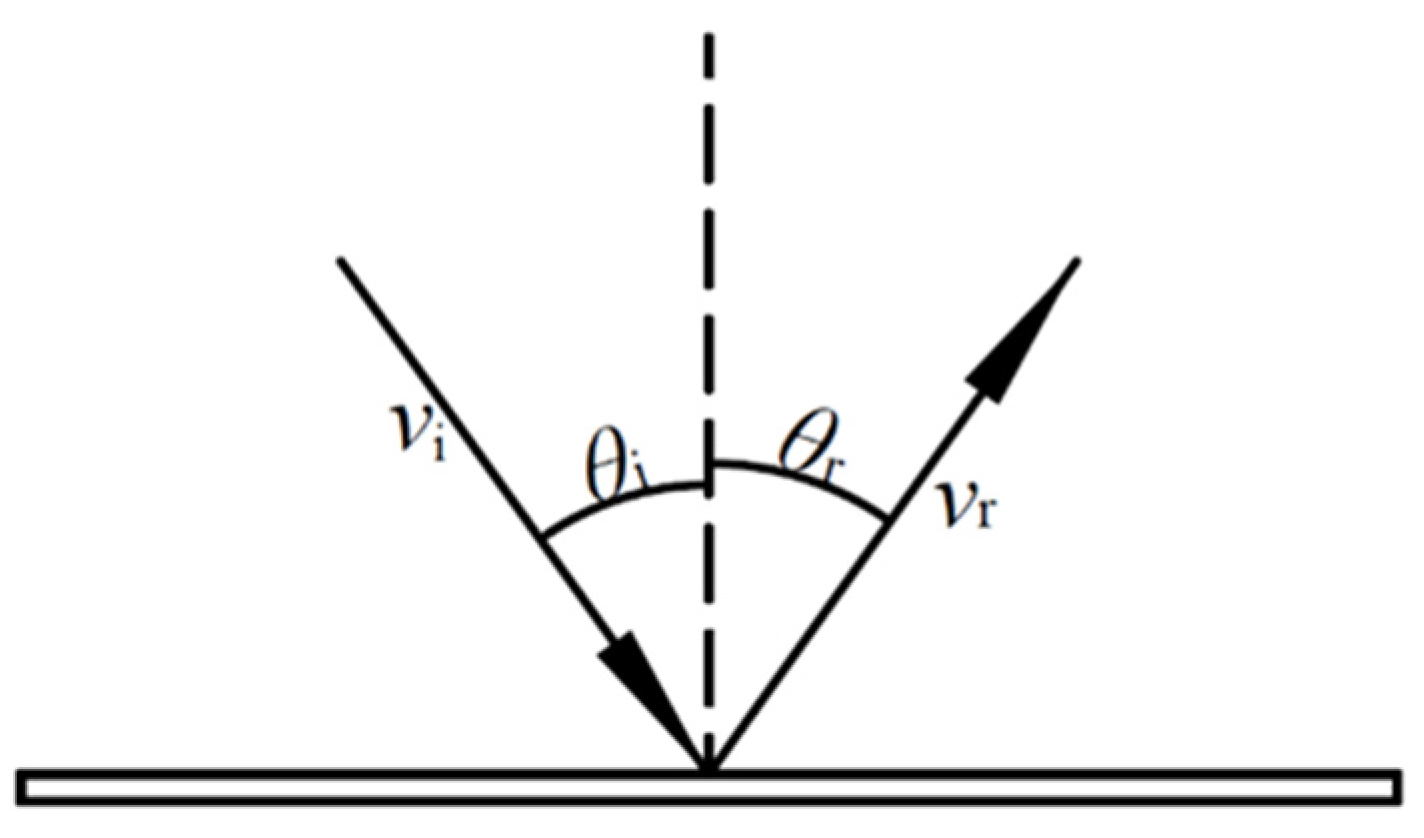

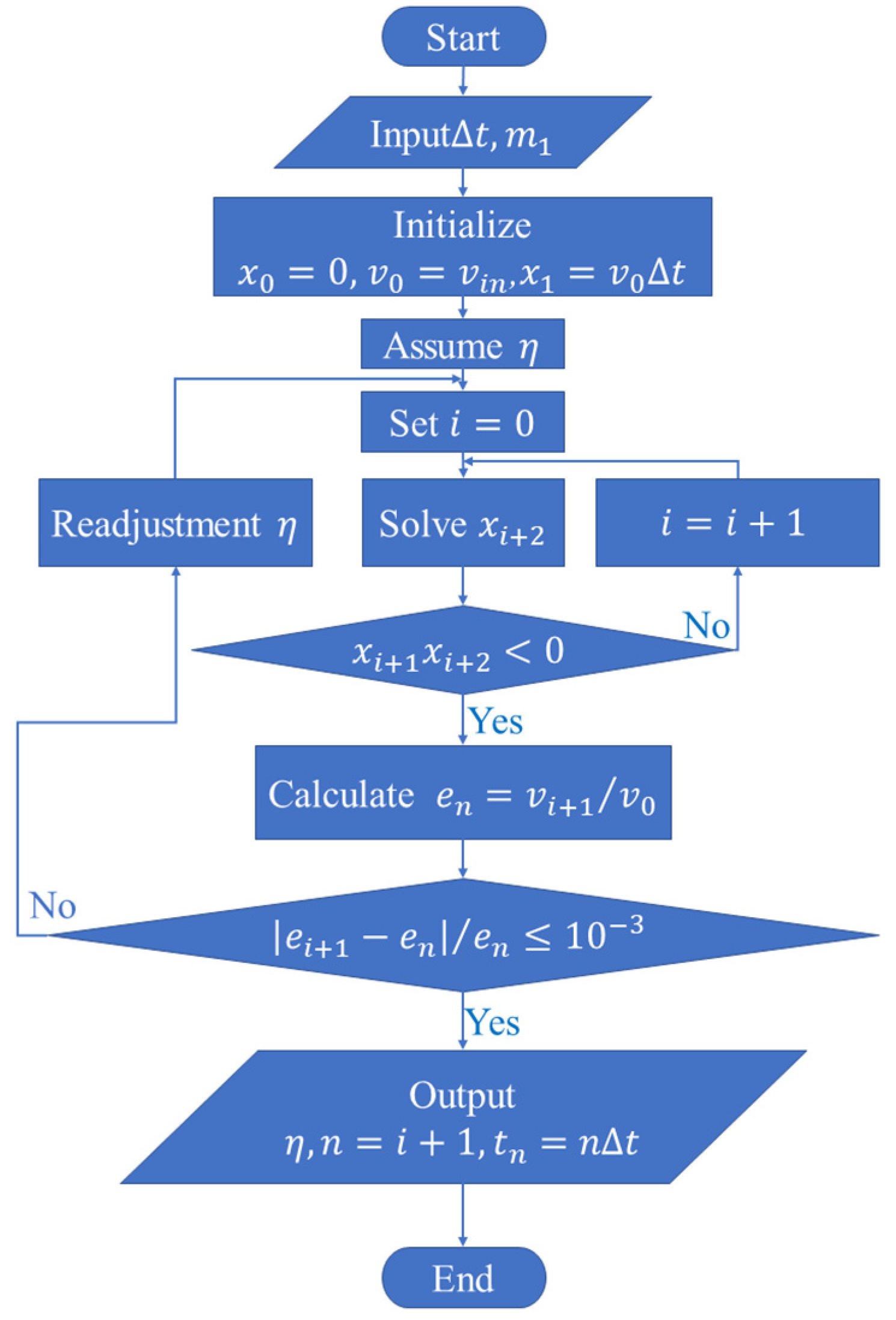

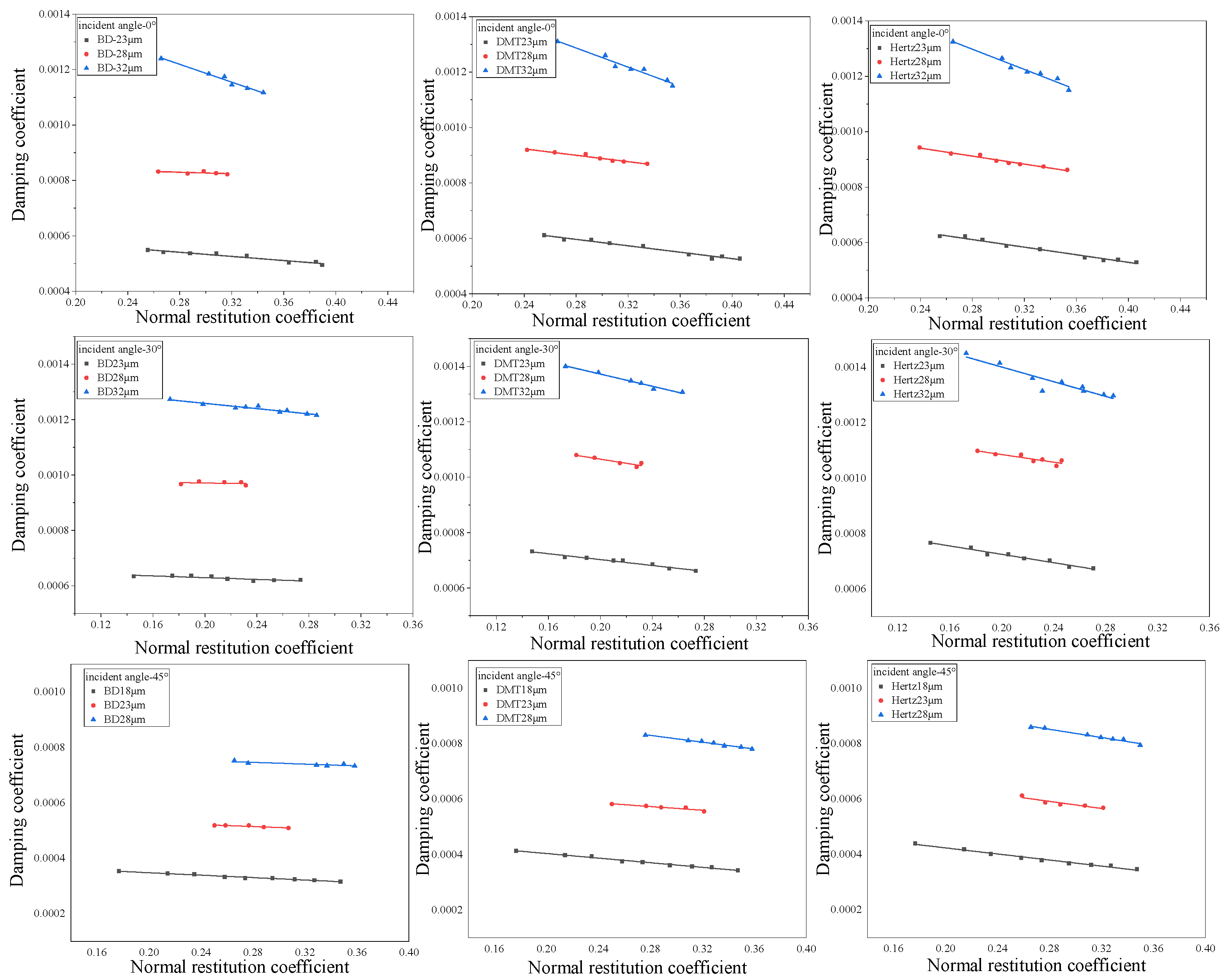
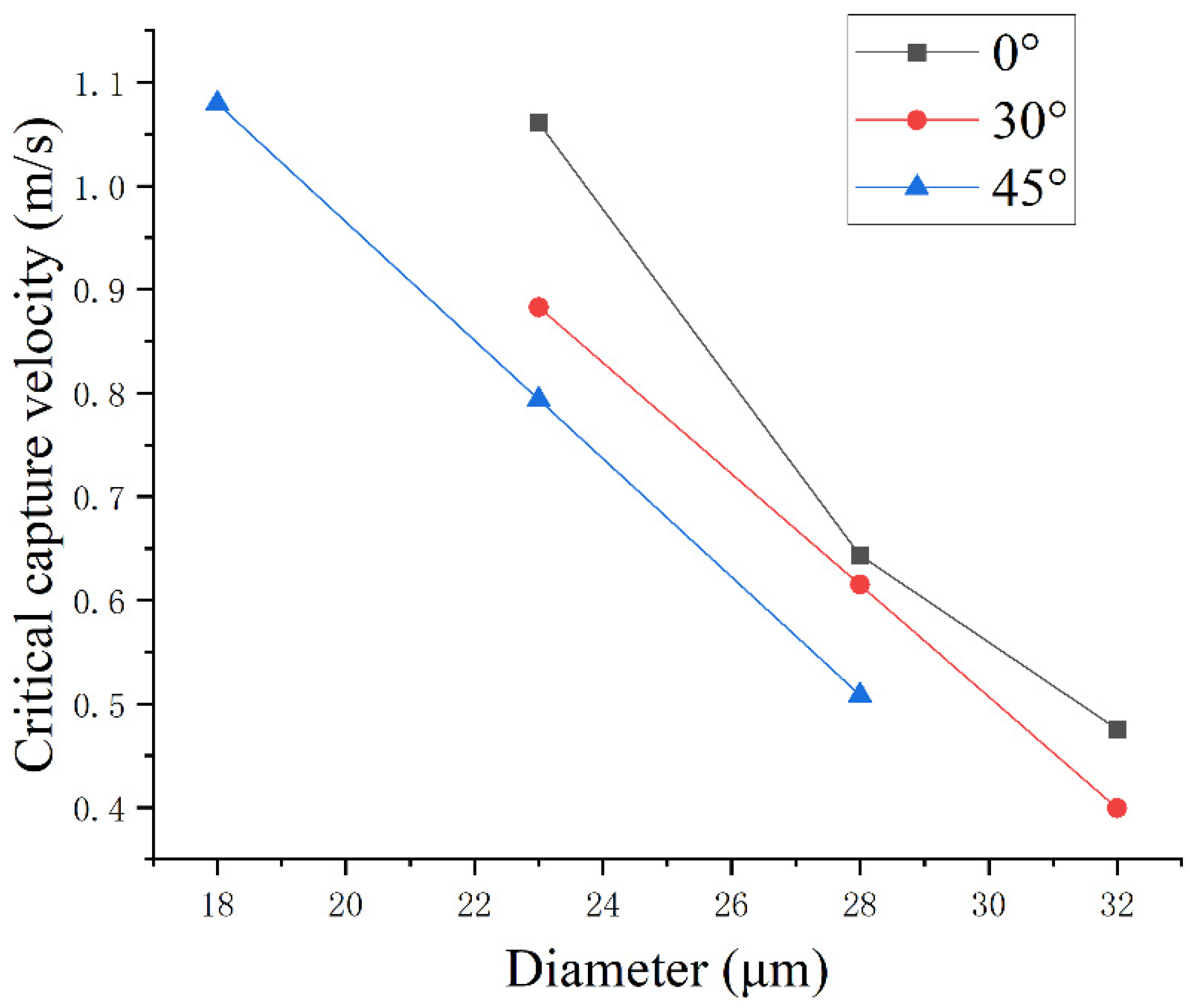
| Serial Number | Indicators | Parameter |
|---|---|---|
| 1 | Resolution ratio | 256 × 256 |
| 2 | Shooting rate | 66,037 fps |
| 3 | Exposure time | 14.705 μs |
| 4 | Embedded memory capacity | 8 G |
| Serial Number | Basic Physical Property Parameters | Unit | Physical Parameter Values |
|---|---|---|---|
| 1 | Particle density | kg/m³ | 2100 |
| 2 | Modulus of elasticity of particles | GPa | 134 |
| 3 | Poisson’s ratio of particles | - | 0.21 |
| 4 | Particle surface energy | kJ/m² | 89.75 |
| 5 | Modulus of elasticity of plate | GPa | 206 |
| 6 | Poisson’s ratio of the plate | - | 0.29 |
| 7 | Plate surface energy | kJ/m² | 247.96 |
| (a) Incident Angle 0° | |||
| Diameter | Hertz Model | DMT Model | BD Model |
| 23 | 0.000905 | 0.000750 | 0.000686 |
| 28 | 0.001200 | 0.000947 | 0.000815 |
| 32 | 0.001490 | 0.001080 | 0.000936 |
| (b) Incident Angle 30° | |||
| Diameter | Hertz Model | DMT Model | BD Model |
| 23 | 0.000881 | 0.000738 | 0.000624 |
| 28 | 0.001170 | 0.000918 | 0.000801 |
| 32 | 0.001360 | 0.001060 | 0.000836 |
| (c) Incident Angle 45° | |||
| Diameter | Hertz Model | DMT Model | BD Model |
| 18 | 0.000574 | 0.000485 | 0.000399 |
| 23 | 0.000801 | 0.000667 | 0.000589 |
| 28 | 0.001070 | 0.000827 | 0.000714 |
| (a) Incident Angle 0° | |||
| Diameter | Hertz Model | DMT Model | BD Model |
| 23 | 0.5725 | 0.7755 | 1.0611 |
| 28 | 0.3316 | 0.4949 | 0.6437 |
| 32 | 0.2589 | 0.3505 | 0.4757 |
| (b) Incident Angle 30° | |||
| Diameter | Hertz Model | DMT Model | BD Model |
| 23 | 0.5020 | 0.7469 | 0.8829 |
| 28 | 0.2961 | 0.4633 | 0.6151 |
| 32 | 0.1651 | 0.3389 | 0.3992 |
| (c) Incident Angle 45° | |||
| Diameter | Hertz Model | DMT Model | BD Model |
| 18 | 0.6746 | 0.9768 | 1.0796 |
| 23 | 0.3133 | 0.5937 | 0.7940 |
| 28 | 0.1902 | 0.3773 | 0.5088 |
| Case | Incident Angle | Diameter (μm) | Incident Velocity (m/s) | Adhesion/Rebound |
|---|---|---|---|---|
| 1 | 0° | 23 | 0.9546 | adhesion |
| 2 | 0° | 23 | 1.0924 | rebound |
| 3 | 0° | 28 | 0.5528 | adhesion |
| 4 | 0° | 28 | 0.6508 | rebound |
| 5 | 0° | 32 | 0.4399 | adhesion |
| 6 | 0° | 32 | 0.4851 | rebound |
| 7 | 30° | 23 | 0.8637 | adhesion |
| 8 | 30° | 23 | 0.8920 | rebound |
| 9 | 30° | 28 | 0.6003 | adhesion |
| 10 | 30° | 28 | 0.6247 | rebound |
| 11 | 30° | 32 | 0.3811 | adhesion |
| 12 | 30° | 32 | 0.4052 | rebound |
| 13 | 45° | 18 | 1.0531 | adhesion |
| 14 | 45° | 18 | 1.0864 | rebound |
| 15 | 45° | 23 | 0.7855 | adhesion |
| 16 | 45° | 23 | 0.8037 | rebound |
| 17 | 45° | 28 | 0.4926 | adhesion |
| 18 | 45° | 28 | 0.5110 | rebound |
Publisher’s Note: MDPI stays neutral with regard to jurisdictional claims in published maps and institutional affiliations. |
© 2021 by the authors. Licensee MDPI, Basel, Switzerland. This article is an open access article distributed under the terms and conditions of the Creative Commons Attribution (CC BY) license (https://creativecommons.org/licenses/by/4.0/).
Share and Cite
Xie, J.; Ma, H.; Li, C.; Li, S.; Zhu, Z.; Fu, Z. The Critical Capture Velocity of Coal Ash Particles Oblique Impact on a Stainless Steel Surface. Energies 2021, 14, 5231. https://doi.org/10.3390/en14175231
Xie J, Ma H, Li C, Li S, Zhu Z, Fu Z. The Critical Capture Velocity of Coal Ash Particles Oblique Impact on a Stainless Steel Surface. Energies. 2021; 14(17):5231. https://doi.org/10.3390/en14175231
Chicago/Turabian StyleXie, Jun, Haodong Ma, Chenxi Li, Shaobai Li, Zhengren Zhu, and Zheng Fu. 2021. "The Critical Capture Velocity of Coal Ash Particles Oblique Impact on a Stainless Steel Surface" Energies 14, no. 17: 5231. https://doi.org/10.3390/en14175231






